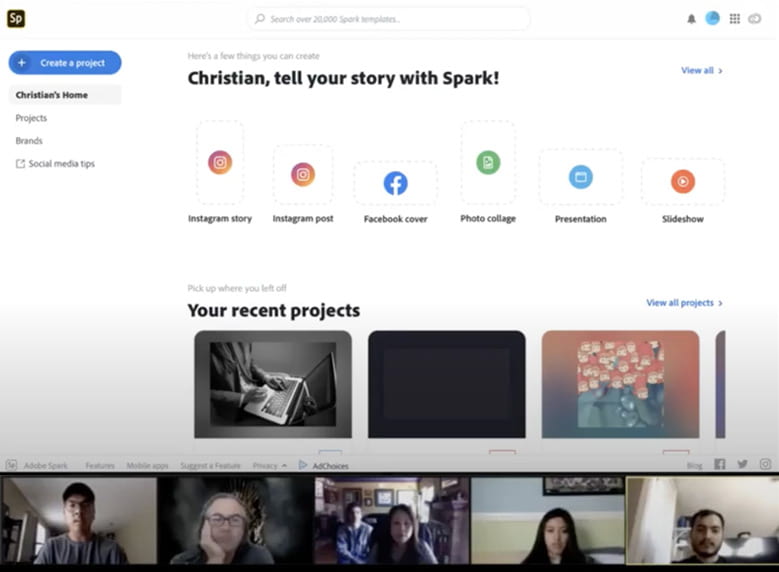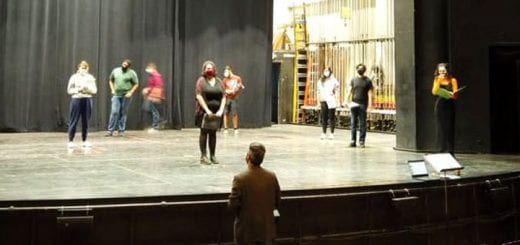Learning Together: Faculty Mentoring
Associate Professor Delacruz’s senior capstone course, where students create awareness campaigns for a local business or nonprofit, takes remote teaching to another level. “They produce videos and coach their clients in real time through Zoom, using all of these tools as extensively as they could do,” Delacruz says. Senior projects are real-world practice for their future advertising jobs.
Christian, the student, shares his screen, displaying a slide about how to use Adobe Spark. Next to the view of his desktop we see his face. Moving images play, but his instructor, Associate Professor John Delacruz stops him. The audio isn’t playing.
“See the two boxes you need to check?” Delacruz gently advises.
“Oh, yeah, I see,” Christian replies. “Both?”
“Yep!”
He and his classmates are producing material for their advertising client, A Slice of New York pizza shop. Co-owners Marguerite Lee and her husband, Kirk Vartan, are here in the Zoom session, too, watching and listening to Christian’s tutorial. No wonder he’s intently focused. “With a couple clicks, you’re able to create some pretty cool visuals,” Christian explains.
By the end of the session, the clients are impressed. Delacruz wraps up, telling the clients, “You can bring your branding elements into it. This takes it up another level. You’ve got the messaging that these guys will have put together for you.”
Learning remotely, it turns out, applies directly to practicing for a profession.
“In our industry,” Delacruz says, “we already work with clients based on the east coast, freelancers in Canada or Central America or Europe. It’s already happening. When we say we learn by doing at San José State, it really is true. Even in this online crisis moment, our students are learning skills that are really going to help them in the workplace.”
A Crisis Requires All Hands
Every year San José State sends about 10,000 graduates—engineers, teachers, accountants, artists—into the workforce of the Silicon Valley region and beyond. To do that, its instructional community must work as a team. To improve remote learning during the COVID-19 pandemic, everyone needed to huddle up before fall semester began. Challenges faced by physics professors running laboratories relate directly to the dance or drama professor whose instruction is all about performance. Through interdisciplinary mentoring, both formal and informal, faculty members turned to each other for a helping hand. It’s been a summer of virtual handholding—in this strange year where in-person contact feels fraught with peril.
Delacruz mentored a group of about 25 faculty members in SJSU’s Teach Online Summer Certificate Program, a three-week course designed to prepare for the transition. A thousand SJSU faculty members signed up. “That’s about half of the faculty,” says Deanna Fassett, assistant vice provost for faculty development. “It definitely outpaced what I was thinking would happen.” With support from the Online Learning Consortium (OLC), the trainings were designed by the Center for Faculty Development, eCampus and the Office of Diversity, Equity and Inclusion (ODEI). Each faculty member took four required modules and three elective modules—perfecting advanced use of Canvas, or timesaving grading strategies.
Delacruz felt his remote teaching experience would make him an effective mentor to his colleagues, he says. Many “zipped through the online course. It gave them new ideas. I could see them taking them on board and applying them.” As a faculty mentor, Delacruz says, he could “cheer along the one who’s limping or struggling and help them.” Delacruz is good with technology, which helps. “You get to know these tools. I can go in and take over somebody’s computer and help and show them how to do it. And I was happy to do it.”
Delacruz characterized his mentees’ determination: “We feel a sense of responsibility. As faculty members, everybody really wants to make sure our students get the best experience—whether that’s in person or online.”
For many faculty members who love teaching in front of a class, moving to online instruction was a scary and difficult shift. Associate Professor of Anthropology Charlotte Sunseri, a passionate, award-winning teacher who took the summer training, says teaching remotely made her feel a bit overwhelmed. “The more I knew the more I realized I didn’t know. But I felt like I was in a community of scholars who were all in it together. We’re all figuring it out together.”
And when walking into the dark, it’s good to hold hands. (Metaphorically only! From distance!)
Sheri Rickman Patrick, assistant professor of nursing, teaches both undergrads and working nurses who are graduate students. During the summer training, she says, “I found some really good tools.” She says one module emphasized “figuring out your endgame: What do you want the students to walk away with—and then working backwards. That was really good.” Rickman Patrick says SJSU’s entire Valley Foundation School of Nursing would likely transition to putting all its course exams on Canvas.
Rickman Patrick learned from her group’s summer mentor, Music Lecturer Steven Lin, a world-renowned classical guitar expert. “Steven, my mentor, is a working musician who teaches music and does a lot of videos,” Rickman Patrick says. Involving video in remote nursing instruction was an idea Rickman Patrick had planned to implement. After Lin demonstrated his technique, it made more sense. “He was teaching me how to do a video,” she says, “and walked me through how he does it.” Lin told Rickman Patrick to contact him if she had any issues or just wanted him to look at it and offer feedback.
Fassett says universities often have barriers to cross-disciplinary collaboration. “CFD has always aspired to nurture those collaborations, but it’s taken this present crisis to really ignite them.” Fassett says small groups allowed faculty members to grapple together. “Even though it’s strange and new for most of them, it’s a space where they’re getting some community that they didn’t have in the spring when we had to shift so quickly.”
A Summer to Prepare
“It’s possible to do some amazing things,” Fassett says—but it meant rethinking some basics. “It reminds me of when somebody goes vegetarian and tries to recreate meatloaf with, let’s say, wheat loaf? Of course it’s not going to taste the same as meatloaf. But if you made some really great squash risotto, you’d enjoy what you were having.” Her point? Remote learning should not be a face-to-face class stuffed into the Zoom application. Also, time invested up front is well spent. Fassett says, “Everything requires this extra intentionality. That’s a new way of thinking. You can’t just wing it. You have to be so much more organized.”
Teaching Assistants trained for fall too. Normally in the Department of Communication Studies, TAs would be preparing to teach undergraduate introductory public speaking classes in person. “Technology was something of an afterthought,” says Associate Professor Tabitha Hart. “An add on.” TAs might use Canvas minimally, deploying some of its features. “But it wasn’t something we talked about. This year is a radical turnaround.”
Hart trained eight incoming TAs with the help of Laura Bell, a returning graduate student. Having moved her own teaching online suddenly last spring, Bell was well poised to help the fall TAs understand what they would face. New TAs who did their practice teaching online got a few do-overs, instead of one shot in front of Hart, Bell says. For some, the scary moment of first facing down a roomful of undergrads might actually be less scary this year.
Hart says, “I give props to Laura. She’s been a fantastic mentor. They did an excellent job and are now well prepared. But it was a heavy lift.”
TA training in communication studies will have an online component from now on, Hart says. “Even after the pandemic, TAs may blend it in, but it will be an invaluable piece. There are long-term takeaways.” Expertise in teaching online has “actual monetary, job market value” for grad students who can list online teaching on their resumes, Hart says. “They take teaching seriously and want to do a good job. They come in with a high level of motivation and drive.”
Supporting a Caring Community
Delacruz says teaching online still meant supporting students emotionally. “My message through my whole mentoring period was ‘teaching is teaching,’” Delacruz says. “You’re still engaging in the same practice. Same approaches and philosophies, but different tools. Play with things, try things out. Don’t be afraid to fail. Through failure we learn new skills. Just learn!” Delacruz says.
Nevertheless, leave no doubt: It’s a hard time for everyone.
Fassett says faculty mentors did “a fair degree of grief counseling too. It’s hard to make this turn. It’s hard to change what you’ve been doing.” She praised the readiness she has seen, and says investments made now will pay off post-pandemic. “Even when they can go back to face-to-face instruction, they will be stronger for having had this experience. There will be closures, there will be earthquakes, there will be other disruptions,” she says. The summer training modules supported faculty members with a window of time to learn and prepare. “Our faculty members are ideal for this moment,” Fassett says. “They leaned into it. They realized: We still have students. We’re still making knowledge.”
Sunseri says what she learned over the summer would help her accomplish what she valued most in the first place—building relationships.
One of her favorite takeaways from the summer session was to rebrand the term “office hours.” “I might call it online happy hour, or coffee break or tea time with the professor, maybe four times through the semester,” she says. Sunseri missed getting to know students in casual conversations. “Chatting about our world and ourselves and how we’re getting through this. I loved that idea. That’s a huge component that’s missing online—the casual chatting with students before or after class, the personality you bring to the classroom. I think I’m going to take that on. It’s really about how you mentor students on the side, encourage them, help them see career pathways. Get to know them as people. I didn’t want to lose that entirely going online.”






